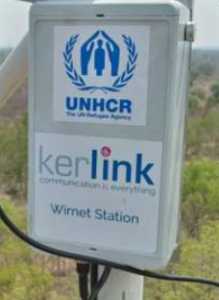Kerlink LoRaWAN gateway technology powering UN water-monitoring program serving refugees
Feb. 26, 2020
 The pilot Internet of Things (IoT) program overseen by the United Nations High Commissioner for Refugees (UNHCR) began in January 2019 with reservoir monitoring in Uganda and Iraq. The Ugandan Arua Field effort alone provides daily water deliveries to as many as 470,000 refugees.
The pilot Internet of Things (IoT) program overseen by the United Nations High Commissioner for Refugees (UNHCR) began in January 2019 with reservoir monitoring in Uganda and Iraq. The Ugandan Arua Field effort alone provides daily water deliveries to as many as 470,000 refugees.
LoRaWAN-enabled sensors installed at reservoirs enable managers to monitor water levels in real time, providing unprecedented visibility into usage and resource management.
Data from the sensors designed by several companies travels through an outdoor Kerlink Wirnet™ Station LoRaWAN gateway, which provides essential connectivity with cloud databases and applications. UNHCR managers integrate the data into a dashboard that provides new levels of visibility into operations of the program.
Expanding to eight more sites
The effectiveness of the monitoring programs in remote locations is prompting expansion to eight additional sites in Uganda, Iraq, Kenya, Rwanda, Tanzania and Bangladesh, and officials see a multitude of potential applications for IoT-based wireless sensor networks going forward.
UNHCR Water, Sanitation and Hygiene (WASH) Officer Ryan Schweitzer noted that the IoT made it both easy and cost-effective to roll out a static water-level monitoring system. The agency hopes to use it globally as a “basis-of-payment‟ system for water-trucking operations, whose costs in Uganda are as high as $15 million per month.
“The LoRaWAN IoT technology is mature, extremely cost effective and scalable. The static reservoir-monitoring technology works extremely well,” Schweitzer said.
“This unique and vital use case underscores the humanitarian benefits that the IoT can support,” said Stéphane Dejean, Kerlink’s chief marketing officer. “Because the UNHCR sensor-to-gateway-to-platform system provides critical life support for large numbers of people, there’s a very high need for trustworthiness and reliability.”
‘Possible game-changer for monitoring in refugee settings’
The UNHCR, the UN’s refugee agency, is charged with providing water to millions of people worldwide, often with daunting logistics. Schweitzer explained that the LoRaWAN approach has broad potential for all sectors of humanitarian services, including monitoring of groundwater, water-supply systems, water quality, waste collection, and air quality. He described it as a “possible game-changer for monitoring in refugee settings,” noting that the ability to document delivery of safe, potable water to refugees at all times is a “holy grail”-type of technology for UNHCR water and hygiene efforts.
Since its introduction in 2014 as the first commercial LoRaWAN® gateway, Kerlink’s Wirnet Station has been chosen for thousands of installations worldwide by public operators, cable operators, private businesses, and public authorities. It has set new standards for robust, reliable, high-performance operation; an upgraded successor, the Wirnet iStation, was introduced in 2019.
“The project’s remote location and minimal staffing demanded a true carrier-grade solution with quick, easy integration and deployment, and secure and straightforward administration. We’re gratified by our Wirnet Station’s performance under harsh conditions, and honored to work with UNHCR. Their work reflects our values and commitments towards society and the environment, and we look forward to continuing to provide expertise on the next round of projects.”
Stéphane Dejean, Kerlink’s chief marketing officer


